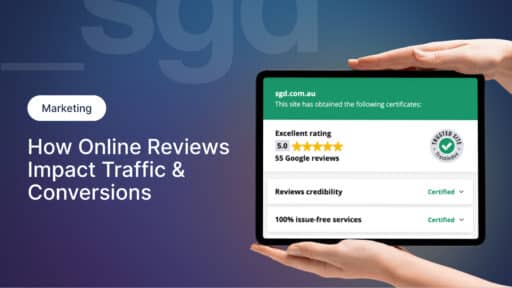The 5 Keys Factors for Choosing Content Topics That Drive Website Traffic
March 24, 2025 — SGD Team

Picking content topics isn’t just guesswork— it’s about strategy.
To create content that actually attracts visitors, you need to consider more than just search volume.
Here are five essential factors to help you choose topics that will drive traffic and lead to real business results.
1. Search demand: are people looking for it?
If no one is searching for a topic, it won’t bring in traffic— no matter how well-written it is.
How to find topics with search demand:
- Use tools like Google Keyword Planner, Ahrefs, Semrush or SE Ranking to check monthly search volume.
- Look at Google’s autocomplete suggestions— they show what people commonly search for.
- Browse the “People Also Ask” section in Google search results for related questions.
Action step: Search for a keyword related to your industry and check the suggested searches at the bottom of Google results— these are real user queries worth exploring.
2. Relevance: does it align with your business & audience?
Just because a topic has high search volume doesn’t mean it will attract the right visitors.
Ask yourself:
- Would potential customers search for this?
- Does this topic naturally connect to our products or services?
- Can we provide unique value on this topic?
For example, a personal trainer might be tempted to write about “Best Running Shoes” (high traffic potential), but a better fit might be “How to Prevent Running Injuries” (directly relevant to their expertise).
Action step: Before creating content, define who you want to reach and how this topic supports your business goals.
3. Competition: can you realistically rank for it?
Some search keywords are so competitive that it’s very difficult to rank in the top results.
How to assess competition levels:
- Search your topic on Google— are the top results big brands like Wikipedia or Forbes?
- If yes, find a more specific, long-tail variation (e.g., “Best SEO tools for local businesses” instead of “Best SEO tools”).
- Use an SEO tool to check keyword difficulty— lower scores mean easier ranking opportunities.
Action step: If the top-ranking pages are huge websites, refine your topic into a niche where you have a better chance of ranking.
4. Evergreen vs. trending: is it a long-term or short-term topic
Some topics spike in traffic for a short time (trending topics), while others consistently attract visitors over months or years (evergreen topics).
Evergreen topic examples:
- Stay relevant for a long time (e.g., “How to Increase Website Traffic“)
- Consistently drive traffic over time
- Are great for SEO and long-term content strategy
Trending topic examples:
- Gain quick bursts of traffic (e.g., “Google’s Latest Algorithm Update”)
- Fade over time but can attract early visitors
- Work well for news-based or seasonal content
Action step: Aim for a balance— create mostly evergreen content, but mix in trending topics to take advantage of temporary traffic spikes.
5. Content Gap: is there an untapped opportunity?
Sometimes, the best topics aren’t the most obvious ones. A content gap happens when there’s demand for a topic, but existing content isn’t fully addressing it.
How to identify content gaps:
- Look at top-ranking pages— are they outdated or missing key details?
- Check forums like Reddit, Quora, or industry groups to see what questions people are asking.
- Use tools like Ahrefs’ Content Gap tool to find keywords competitors rank for that you don’t.
Example: If most articles on “Best web designer” only cover general options, you could create “Best WordPress website designer in Melbourne”— a more specific, underserved version of the topic.
Action step: Find a weak spot in existing content and create something more complete, more useful, or better targeted than what’s already out there.
Next steps: turn ideas into results
- Check search demand— focus on topics people are actively searching for.
- Align content with your business goals— make sure it attracts the right audience.
- Assess competition— target realistic keywords where you can rank.
- Balance evergreen and trending content— stay relevant long-term while capitalising on trends.
- Identify content gaps— find opportunities to cover topics better than competitors.
By applying these five factors, you can create content that not only drives traffic but also attracts the right visitors— leading to more conversions, leads, and sales.
Need help creating high-impact content for your website?
Our team of SEO copywriters in Melbourne can help – contact us and let’s review your SEO potential.
Author

SGD Team
We’re the team at SGD, a Melbourne web design and search marketing agency. We specialise in creating bespoke websites that function as powerful marketing and sales tools, driving measurable results to help your organisation grow. Contact us today to see how we can boost your online presence and drive success for your business.
Unlock Weekly Insights To Improve Your Website
Want to improve your website and digital marketing? Sign up to Marketing Monday for practical, up-to-date strategies on SEO, Google Ads, and website performance—delivered weekly.
No fluff, just results-driven advice. Unsubscribe anytime.
Next Article
Client Spotlight: Mint Cleaning
March 16, 2025Start a Project








